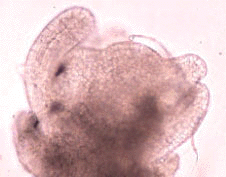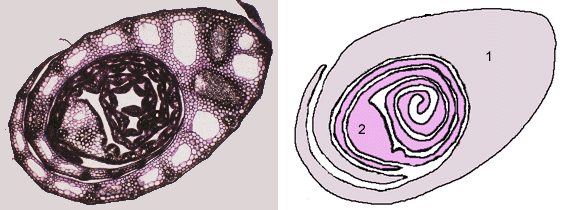
A leaf primordium is differentiated from a little below the SAM. As it develops, it elongates and forms a cone-shaped structure around the SAM. At the top of this structure, the mid-rib starts to differentiate. Soon after, smaller veins start to form on both sides of its base, and later in between larger veins. These are the early stages of leaf blade formation.
When the primordium has grown to about 8 mm, a cavity develops at its base. The auricles and the ligule will be differentiated from this location, which will be differentiated into the collar: The collar separates the blade and the sheath.
After the cavity has formed, the meristem that is responsible for elongation is activated and the blade starts to elongate. During this period, smaller vascular bundles and connections between them are formed, internal structures such as epidermis, mesophyll and stomata are also formed.
Note that as the blade develops, it is
enclosed by the sheath of a larger leaf right outside it, and a young leaf
will not emerge from it until its blade has attained full length and size.
Also note that the sheath still has not started to elongate.

Now the blade has grown to its full size, and its cells have stopped dividing; the blade is ready to emerge.
As the blade emerges, it unrolls from its tip down to the base. At this stage, its internal structures have fully developed, so that photosynthesis and transpiration can begin as soon as the blade emerges.
As it unrolls, cells in the blade expand to reach a larger size. This is why an older leaf is wider and longer that a newly emerged leaf--not because it has more cells; but because its cells have grown larger.
As soon as the blade starts to expand,
the leaf sheath starts to elongate. At the same time, internal structures
of the sheath also start to differentiate. The sheath completes its elongation
when the blade has fully expanded.